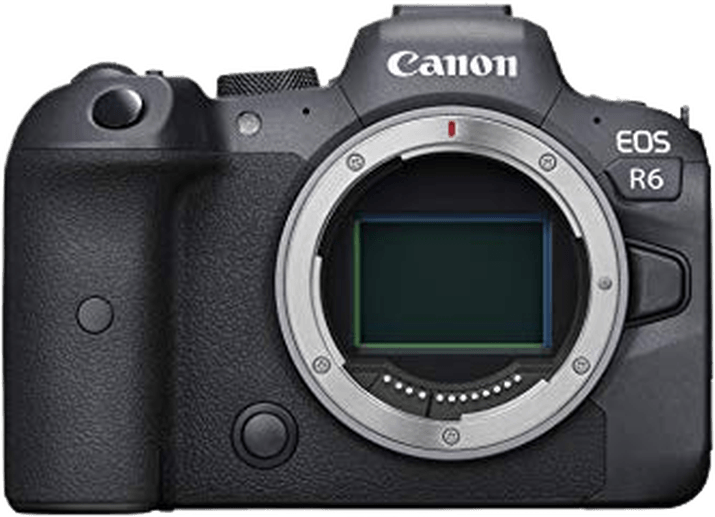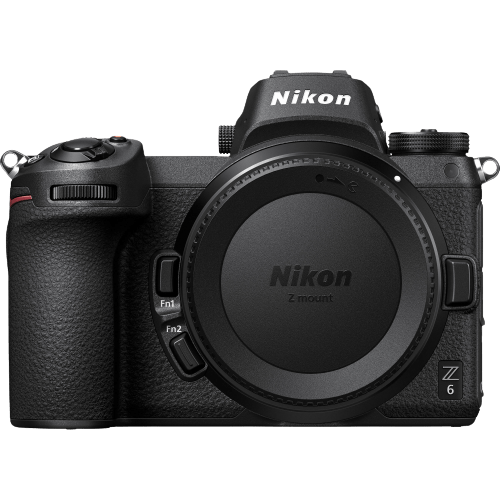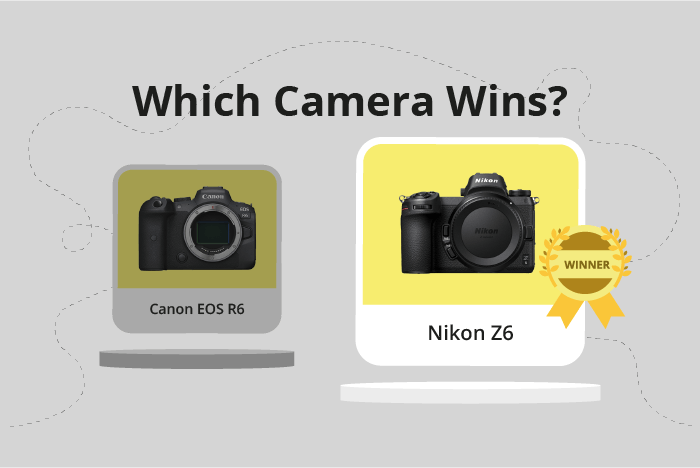Canon EOS R6 vs Nikon Z6 Comparison
Canon EOS R6

Nikon Z6

The Nikon Z6 edges out the Canon EOS R6 with a score of 81/100 compared to 80/100. Both cameras are mirrorless and share similarities in size and weight, with the Nikon Z6 measuring 134 x 101 x 68mm and weighing 675g, while the Canon EOS R6 comes in at 138 x 98 x 88mm and 680g.
The Canon EOS R6 has a higher launch price of $2499 compared to the Nikon Z6’s $2000. Despite the price difference, the Nikon Z6 still manages to outperform the Canon EOS R6 by a slight margin. This could be due to factors such as image quality, autofocus performance, or other features that are not reflected in the general specifications.
On the other hand, the Canon EOS R6 is a more recent release, hitting the market in 2020, while the Nikon Z6 was released in 2018. This means that the Canon EOS R6 may offer more advanced technology and features, justifying its higher price.
Taking these points into consideration, the Nikon Z6 offers a slightly better performance at a lower price, while the Canon EOS R6 brings the advantage of more recent technology.
Canon EOS R6 vs Nikon Z6 Overview and Optics
The Nikon Z6 outperforms the Canon EOS R6 in optics, with a score of 83/100 compared to the Canon’s 79/100. Both cameras share several key specifications, such as a CMOS sensor, full-frame sensor size, and image stabilization. Additionally, both cameras feature their respective brand’s lens mount: Canon RF for the EOS R6 and Nikon Z for the Z6.
The Nikon Z6 surpasses the Canon EOS R6 in two crucial aspects: megapixels and DXOMARK score for the sensor. The Z6 boasts 24.5 megapixels, while the R6 has 20.1 megapixels, giving the Nikon Z6 an advantage in image resolution. Moreover, the Z6 has a higher DXOMARK sensor score of 95, compared to the R6’s 90, indicating better overall image quality.
On the other hand, the Canon EOS R6 outshines the Nikon Z6 in shooting speed. With a speed of 20 frames per second, the R6 doubles the Z6’s 12 frames per second. This faster shooting speed makes the R6 more suitable for capturing fast-moving subjects and action photography.
In terms of their processors, the Canon R6 uses a Digic X processor, while the Nikon Z6 employs an Expeed 6 processor. Although both processors are efficient, it’s difficult to directly compare them as they are designed specifically for their respective camera brands.
Taking all factors into consideration, the Nikon Z6 claims the optics victory with its higher megapixel count and superior DXOMARK sensor score, making it ideal for photographers seeking top-notch image quality. However, the Canon EOS R6 remains a strong contender for those prioritizing fast shooting speeds in their photography.
Canon EOS R6 vs Nikon Z6 Video Performance
The Canon EOS R6 outperforms the Nikon Z6 in video capabilities with a score of 91/100 compared to the Nikon’s 83/100. Both cameras share common features such as 4K maximum video resolution, 3840 x 2160 maximum video dimensions, and built-in time-lapse functionality.
The Canon EOS R6 excels with its higher maximum video frame rate of 120fps, doubling the Nikon Z6’s 60fps. This enables the EOS R6 to capture smoother slow-motion footage, providing more creative flexibility for videographers. The higher frame rate also allows for better performance in fast-paced situations, such as sports or wildlife videography.
The Nikon Z6 does not have any significant advantages over the Canon EOS R6 in terms of video capabilities. Its lower video score and maximum frame rate place it at a disadvantage compared to the EOS R6. However, it is essential to consider other factors such as price, ergonomics, and lens availability when making a final decision between the two cameras.
Given the differences between the Canon EOS R6 and Nikon Z6, the EOS R6 emerges as the better choice for videographers due to its superior video performance. The higher video score and maximum frame rate set it apart from the Nikon Z6, providing smoother slow-motion and better performance in fast-paced situations. While the Nikon Z6 remains a solid option for photography, those prioritizing video capabilities should opt for the Canon EOS R6.
Canon EOS R6 vs Nikon Z6 Features and Benefits
The Nikon Z6 surpasses the Canon EOS R6 with a feature score of 87/100 compared to the R6’s 85/100. Both cameras share common specifications, such as a touchscreen, WiFi, and Bluetooth connectivity. They also lack GPS functionality.
The Nikon Z6 outperforms the Canon EOS R6 in terms of screen size and resolution. The Z6 boasts a 3.2-inch screen with a resolution of 2,100,000 dots, providing a larger and sharper display than the R6’s 3-inch screen with 1,620,000 dots resolution. This advantage allows for better image preview and menu navigation on the Nikon Z6.
On the other hand, the Canon EOS R6 features a flip screen, which the Nikon Z6 lacks. This flip screen is beneficial for photographers and videographers who need to capture images or record videos from various angles and positions. This feature provides the R6 with more versatility in certain shooting situations.
Considering these points, the Nikon Z6 is superior in terms of screen size and resolution, making it an excellent choice for users who prioritize display quality. Conversely, the Canon EOS R6’s flip screen adds flexibility in capturing images and videos from different angles. Both cameras are strong contenders with unique strengths in their feature sets, making the final decision dependent on individual preferences and specific use cases.
Canon EOS R6 vs Nikon Z6 Storage and Battery
The Canon EOS R6 outperforms the Nikon Z6 in storage and battery with a score of 68/100 compared to Nikon’s 35/100. Both cameras have USB charging capabilities and share similar battery types, with the Canon using LP-E6NH and the Nikon using EN-EL15b.
Canon’s R6 has two memory card slots, accepting SD, SDHC, and SDXC cards with UHS-II compatibility. This is a significant advantage over the Nikon Z6, which has only one memory card slot and accepts XQD cards. This allows the Canon R6 users to have more storage options and flexibility.
Moreover, the Canon R6 offers a longer battery life with 360 shots, while the Nikon Z6 provides 310 shots. The extended battery life of the Canon R6 allows for more photos to be taken without needing to recharge or replace the battery.
Despite the lower score, the Nikon Z6’s use of XQD cards can provide faster read and write speeds, which may benefit some users. However, given the dual card slots and longer battery life, the Canon EOS R6 is the superior choice for storage and battery capabilities.
Alternatives to the Canon EOS R6 and Nikon Z6
Are you still undecided about which camera is right for you? Have a look at these popular comparisons that feature the Canon EOS R6 or the Nikon Z6:

